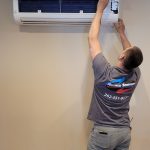In Australia’s rapidly changing industrial and environmental setting, protecting a worker’s respiratory health is an issue beyond compliance. Cutting-edge companies are now working with ISO 14001 consultants to incorporate Mask Fit Test procedures into their Environmental Management Systems (EMS), which improves ecosystem performance along with human safety. This novel approach treats respiratory protection as an element of sustainable corporate social responsibility instead of a safety measure.
Shifting Focus of ISO 14001 Consultants
In the past, ISO 14001 consultants concentrated on optimizing energy consumption, reducing the waste stream, enabling legal compliance, and curtailing the environment’s emissions footprint. Now, top-tier organizations bring these specialists to assist in occupational health, understanding that worker wellness and sustainability are intrinsically intertwined. Mask Fit Test programmes consultancy enables alignment of PPE selection, fitting, and disposables with the organization’s eco-sustainability objectives, thus transforming respiratory protection into an eco-efficiency measure.
Integrating Mask Fit Testing into the EMS
Integrating Mask Fit Tests into the “Plan-Do-Check-Act” cycle of ISO 14001 ensures that these checks receive the same attention as other environmental controls. In the planning phase, consultants consider region-specific hazards like the danger of bushfire smoke in Victoria and silica dust in quarries in Western Australia, and set the appropriate fit-test intervals. During “Do,” fit-testing intervals are documented just like emissions, waste, and resource audits are. “Check” involves data capture on the percentage of fit-test failures and filter dependent usage and performance evaluations while “Act” captures correcting actions—optimizing ventilation or upgrading mask models—placed in the context of continuous improvement programs.
From Disposable to Reusable
Strategies to address PPE in Australia’s emerging circular economy require special attention. Consultants specializing in ISO 14001 offer businesses balance-of-savings analyses that pit single-use masks against reusable respirators with blank filter slots. Systems that utilize reusable components require strict fit-testing along with upfront spending, but result in reduced waste from landfills and less emissions in alterable supply chains. When these assumptions are made, it is easy to quantify the measures taken enhances competitiveness while portraying corporate sustainability in waste-laden markets.
Proactive Respiratory Protection With The Help Of Digital Tools
The digitization of fit-testing methods and monitoring systems is turning safety audits into health programs. IoT (Internet of Things) powered fit-test booths and wearable monitors measure exposure and seal integrity as tasks are completed. This is performed for operations like spray painting in Melbourne’s industrial basins and plain construction in the suburbs around Brisbane. Air Quality Index (AQI) and VOC (Volatile Organic Compound) readings permit supervisors to retrieve data while monitoring enclosed EMP dashboards. This allows for the respiratory performance data to be cross compared and integrated with the data on the surrounding environment. Furthermore, performance concerning air ventilation is mitigated due to lapses in process transparency. Efficiency enables proactive revisions—modifications of masks or adjustments of stringent guidelines above the process defects threshold—before the exposure levels are dangerously or hazardous.
Embedding Personal Health And Planetary Health Together For A Culture Change
Shared responsibility helps engender leadership-induced sustainability safety. These are the exact reasons why Australian employers are taking initiative and creating the “Green Breath” project. This project has ISO 14001 consultants engaging the total workforce on mask care and other border issues using PPE as a focal point. Employees and mask wearers join multidisciplinary collaboration clinics that serve as low effort awareness courses on resource conservation and waste sorting. By integrating mask fitting procedures into other more campaign friendly objectives like tree planting or energy lowering challenges on a corporate-wide scale, organizations foster a culture where the need to care for individual well-being and the inescapable need to care for the planet coalesce.
How Will Workplaces in Australia Look Like in the Future?
With the risk of falling victim to bushfires, heatwaves, and dust storms, Australia certainly does need more resilient respiratory protection strategies. An EMS that combines Mask Fit Test protocols enables organizations to act rapidly to air quality emergencies by automatically initiating fit-testing drives and PPE stockpiling audits. As new threats like nanoparticle exposures in advanced manufacturing frameworks capture attention, ISO 14001 consults help policies within the organization in relating to interaction and alter mechanisms in accordance with the environment management to ensure these frameworks aid in fit-testing drive changes seamlessly along with the new control measures.
Final thoughts
Australian workplaces are being revolutionized by ISO 14001 consultants who reimagine Environmental Management Systems to integrate Mask Fit Testing into their workflows. These collaborative efforts focus on enhancing respiratory protection whiles narrowing the negative impacts on the environment while simultaneously enabling companies to operate as responsible, future-ready organizations. While both breathability and sustainability are crucial in Australia, these organizations spearhead efforts resulting in enhanced employee well-being, corporate resilience, and numerous other advantages.









